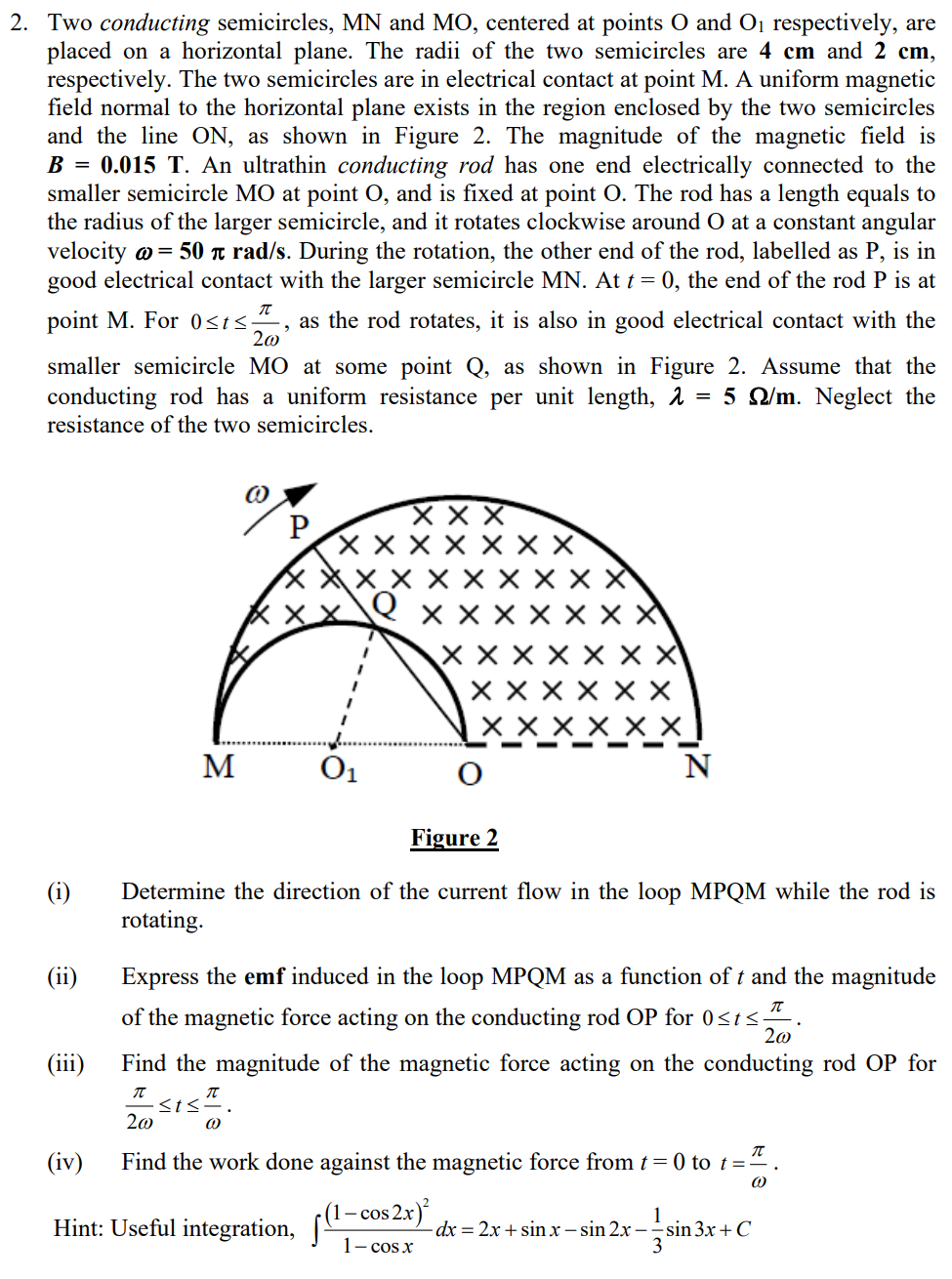2. Two conducting semicircles, MN and MO, centered at points O and O¡ respectively, are placed on a horizontal plane. The radii of the two semicircles are 4 cm and 2 cm, respectively. The two semicircles are in electrical contact at point M. A uniform magnetic field normal to the horizontal plane exists in the region enclosed by the two semicircles and the line ON, as shown in Figure 2. The magnitude of the magnetic field is 0.015 T. An ultrathin conducting rod has one end electrically connected to the smaller semicircle MO at point O, and is fixed at point O. The rod has a length equals to the radius of the larger semicircle, and it rotates clockwise around O at a constant angular velocity good electrical contact with the larger semicircle MN. At t = 0, the end of the rod P is at B @ = 50 t rad/s. During the rotation, the other end of the rod, labelled as P, is in point M. For 0sts: as the rod rotates, it is also in good electrical contact with the 20 smaller semicircle MO at some point Q, as shown in Figure 2. Assume that the conducting rod has a uniform resistance per unit length, 1 = 5 Q/m. Neglect the
2. Two conducting semicircles, MN and MO, centered at points O and O¡ respectively, are placed on a horizontal plane. The radii of the two semicircles are 4 cm and 2 cm, respectively. The two semicircles are in electrical contact at point M. A uniform magnetic field normal to the horizontal plane exists in the region enclosed by the two semicircles and the line ON, as shown in Figure 2. The magnitude of the magnetic field is 0.015 T. An ultrathin conducting rod has one end electrically connected to the smaller semicircle MO at point O, and is fixed at point O. The rod has a length equals to the radius of the larger semicircle, and it rotates clockwise around O at a constant angular velocity good electrical contact with the larger semicircle MN. At t = 0, the end of the rod P is at B @ = 50 t rad/s. During the rotation, the other end of the rod, labelled as P, is in point M. For 0sts: as the rod rotates, it is also in good electrical contact with the 20 smaller semicircle MO at some point Q, as shown in Figure 2. Assume that the conducting rod has a uniform resistance per unit length, 1 = 5 Q/m. Neglect the
Related questions
Question

Transcribed Image Text:2. Two conducting semicircles, MN and MO, centered at points O and O¡ respectively, are
placed on a horizontal plane. The radii of the two semicircles are 4 cm and 2 cm,
respectively. The two semicircles are in electrical contact at point M. A uniform magnetic
field normal to the horizontal plane exists in the region enclosed by the two semicircles
and the line ON, as shown in Figure 2. The magnitude of the magnetic field is
0.015 T. An ultrathin conducting rod has one end electrically connected to the
smaller semicircle MO at point O, and is fixed at point O. The rod has a length equals to
the radius of the larger semicircle, and it rotates clockwise around O at a constant angular
velocity
good electrical contact with the larger semicircle MN. At t = 0, the end of the rod P is at
B
@ = 50 t rad/s. During the rotation, the other end of the rod, labelled as P, is in
point M. For 0sts:
as the rod rotates, it is also in good electrical contact with the
20
smaller semicircle MO at some point Q, as shown in Figure 2. Assume that the
conducting rod has a uniform resistance per unit length, 1 = 5 Q/m. Neglect the
Expert Solution
This question has been solved!
Explore an expertly crafted, step-by-step solution for a thorough understanding of key concepts.
This is a popular solution!
Trending now
This is a popular solution!
Step by step
Solved in 6 steps with 4 images
